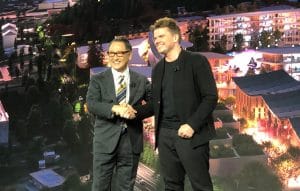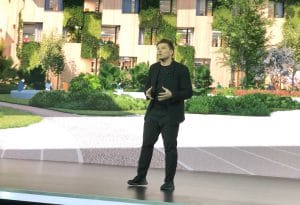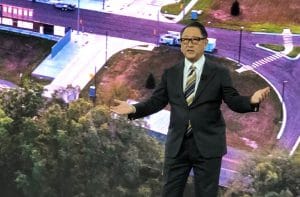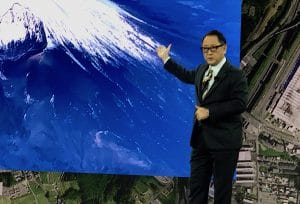Toyota wants to weave itself into the fabric of society – and it plans to do so quite literally by building an all-new city near Japan’s legendary Mount Fuji that will serve as a “living laboratory” to explore clean energy, alternative transportation and other “smart city” concepts.
The giant automaker plans to break ground for what will be called Toyota Woven City in 2021, with a goal of initially having 2,000 people move into the 175-acre complex. The name of the project carries with it a subtle double meaning, Toyota having originally started out as a company making looms and other equipment for the fashion industry.
“Building a complete city from the ground up, even on a small scale like this, is a unique opportunity to develop future technologies, including a digital operating system for the city’s infrastructure,” Akio Toyoda, the CEO of Toyota Motor Corp., and the grandson of its founder, said during a preview at the Consumer Electronics Show in Las Vegas.
(Toyota North America CEO Jim Lentz retiring)
Groundbreaking for the new city – which could expand in later phases – will begin in 2021. The goal is to “have people living there within five years,” said Bjarke Ingels, a Danish architect who specializes in futuristic housing projects, his Bjarke Ingels Group, or BIG, helping Toyota develop the Woven City project.

Toyoda and Bjarke Ingels, a Danish architect who specializes in futuristic housing projects, introduce Toyota’s Woven City.
Cities around the world are facing major challenges today, Ingels and Toyoda stressed during the Toyota presentation and a subsequent media roundtable.
Not only are they watching populations grow but also they are struggling to adapt to issues like pollution, energy and water needs, traffic and the explosion of data-based services and functions.
They are “set in stone and molded by the past,” said Ingels, adding that the challenge is to find ways to help cities adapt to changing times.
Historically, there have been many utopian communities established around the world, though few have succeeded or survived. Toyota Woven City isn’t meant to be another utopian escape but a place where ideas can be tested out and, if they work, applied to existing cities.
“It’s not about technology for technologies sake,” said James Kuffner, CEO of Toyota Research Institute – Advanced Development, one of the subsidiaries that will lead the project. The idea is to come up with useful ideas that, most importantly “put people at the center,” Kuffner added.
One possibility is the project’s unusual road grid. There will be three different types of streets running parallel to each another: one for autonomous vehicles – the only motorized transportation allowed inside the community. Another will be a wide promenade, the third a weaving pathway through a long and narrow park-like setting.
(Toyota offers bright outlook for 2020)
Homes will be constructed out of sustainable materials, including wood, with solar roofs to provide much of their energy needs. Additional power will come from hydrogen fuel cells.
Woven City also will feature a hidden underground lair that will serve as the infrastructural backbone of the community.
Artificial intelligence systems with vast data pipes will be well integrated into Toyota Woven City. That will allow for instant access to infotainment wherever a resident might be. It will be used to oversee community life in other ways, among other things regulating traffic and protecting pedestrians. One of the big challenges, Toyota officials acknowledged, will be staying on top of cybersecurity.
“With people, buildings and vehicles all connected and communicating with each other through data and sensors, we will be able to test connected AI technology in both the virtual and physical realms, maximizing its potential,” said Toyota CEO Toyoda.
The automaker isn’t ready to discuss the cost of the venture but those close to the project privately concede it will be substantial.

Ingels noted that Woven City will never be completed as its the nature of any city to continually change and grow.
Many of the details have yet to be worked out, including the cost of housing for those who move into Toyota Woven City. They are expected to be a mix of current Toyota employees and their families, retirees, scientists, social researchers and others. The plan also calls for a broad cross section of socioeconomic groups to reflect life in other cities.
In something of a surprise, the project leaders have decided that the community’s official language will be English, rather than Japanese, reflecting the goal of bringing in numerous partners – even some of Toyota’s competitors.
(Toyota riding wave of new product launches)
“This city will never be complete,” said Ingels, reflecting the reality that cities are not stagnant and that the living lab of Woven City will constantly seek to embrace and adapt to change.



Reminds me of Biosphere 2 back in the 1990s. Why do people think it’s their job to tell others how to live?
Not intended to dictate how to live but to explore ways to address possible solutions to urban problems. A very different strategy.
Paul E.